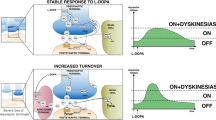Summary
Development of dyskinesia is a common phenomenon during the long-term course of Parkinson's disease. During the last few years some but not all pathogenetic mechanisms causing dyskinesias in PD have been better understood. Severity of Parkinson's disease and levodopa dosing are the main clinical risk factors. Most concepts underline the significance of pulsatile D1-receptor stimulation for the development of dyskinesias. The interactions between D1- and D2-mediated STR-Gpi pathways and co-localized neuropeptides are important but not fully understood. Glutamatergic overactivity might also be a significant pathogenetic factor.
According to these pathophysiological concepts, therapeutic strategies focus mainly on continuous postsynaptic DA-receptor stimulation by long acting DA agonists or highly selective D2 agonists. Another strategy is the use of NMDA antagonists.
Similar content being viewed by others
Author information
Authors and Affiliations
Rights and permissions
About this article
Cite this article
Baas, H. Dyskinesia in Parkinson's disease. Pathophysiology and clinical risk factors. J Neurol 247 (Suppl 4), IV12–IV16 (2000). https://doi.org/10.1007/PL00007767
Issue Date:
DOI: https://doi.org/10.1007/PL00007767




